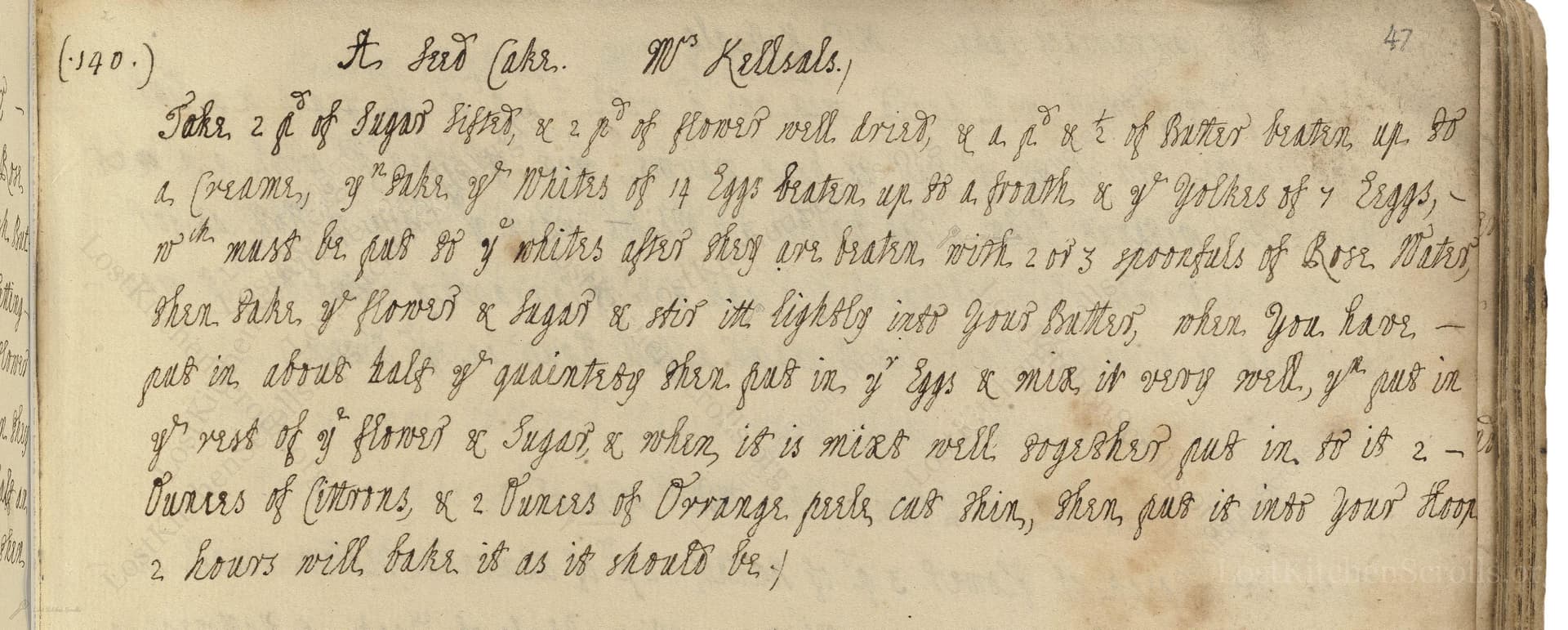A Seed Cake Mrs Kellsals
From the treasured pages of Cookery and medicinal recipes of Dorothy Pennyman
Written by Dorothy Pennyman

A Seed Cake Mrs Kellsals
"Take 2 pd of Sugar Sisted, & 2 pd of flower well dried, & a pd & 1/2 of butterr beaten up to a Creame, yn take ye whites of 14 Eggs beaten up to a froth & ye yolkes of 7 Eggs, - wch must be put to ye whites after they are beaten, with 2 or 3 spoonfuls of Rose Water then take ye flower & Sugar & mix itt lightly into your butterr, when you have - put in about half ye quantity then put in, ye Eggs & mix it very well, ye put in ye rest of ye flower & Sugar & when it is mixt well together put in to it 2 - Ounces of Cittrons, & 2 Ounces of Orrange peels cut thin, then put it into your hoop 2 hours will bake it as it should be."
Note on the Original Text
This recipe is presented in 'receipt' (recipe) form typical of the early 18th century, with a conversational tone and the now-archaic spellings: 'flower' for 'flour,' 'sisted' for 'sifted,' and 'yn' for 'then.' Quantities are large, suited to generous households or special occasions, and eggs are separated with whites frothed for lift. Directions are descriptive rather than precise, reflecting a reliance on skill and experience rather than exact timing or measurements. Modern bakers benefit from metric weights, but the essence is a rich, celebratory cake, written in the elegant, slightly whimsical idiom of its time.

Title
Cookery and medicinal recipes of Dorothy Pennyman (1730)
You can also click the book image above to peruse the original tome
Writer
Dorothy Pennyman
Era
1730
Publisher
Unknown
Background
A delightful glimpse into early Georgian kitchens, this culinary manuscript compiled by Dorothy Pennyman showcases the elegant tastes and recipes of 18th-century England—perfect for those hungry for a taste of history.
Kindly made available by
Folger Shakespeare Library
This seed cake hails from early 18th-century England, compiled by Dorothy Pennyman around 1730. Such cakes were festive fare, rich in eggs and butter, often flavored with distilled waters and candied fruits, reflecting the rising wealth and trade of the time. These cakes were centerpieces for gatherings and symbolized hospitality and abundance in Georgian households. Seed cakes in this era sometimes included caraway or coriander seeds for extra aroma, but this recipe showcases candied peel and rose water as its floral and zesty signatures, a fashionable touch among the English gentry.

The original makers would use a deep wooden or pewter mixing bowl for beating the butter and eggs, probably employing a birch-branch whisk or wooden spoon. The 'hoop' refers to a round, bottomless metal cake mold set upon a parchment-lined baking sheet (or directly on the hearth stone). The cake would be baked in a coal-fired or wood-fired oven, where careful management of the heat was crucial, and the cook might turn the cake during baking for evenness.
Prep Time
45 mins
Cook Time
2 hrs
Servings
16
We've done our best to adapt this historical recipe for modern kitchens, but some details may still need refinement. We warmly welcome feedback from fellow cooks and culinary historians — your insights support the entire community!
Ingredients
- 1.5 pounds caster sugar (sifted)
- 1.5 pounds plain flour (well dried)
- 1.5 pounds unsalted butter (softened)
- 14 large egg whites
- 7 large egg yolks
- 2-3 tablespoons (1-1.5 fl oz) rose water
- 2 ounces candied citron (finely chopped; if unavailable, use mixed peel or lemon zest)
- 2 ounces candied orange peel (finely chopped)
Instructions
- Begin by creaming together 1.5 pounds of sugar and 1.5 pounds of plain flour.
- Dry the flour well before use, as this was common practice to avoid lumps and moisture.
- In a large bowl, beat 1.5 pounds of unsalted butter until it is light and creamy.
- In another bowl, beat the whites of 14 eggs until they form a froth, then gently mix in the yolks of 7 eggs.
- Add 2-3 tablespoons (about 1-1.5 fl oz) of rose water to the eggs.
- Gradually add about half the flour and sugar mixture to the creamed butter, mix lightly, then fold in the beaten eggs.
- Finally, add the remaining flour and sugar, stirring until smoothly combined.
- Stir in 2 ounces of candied citron and 2 ounces of candied orange peel, both cut thinly.
- Pour the batter into a prepared cake tin (historical 'hoop'), and bake for about 2 hours at 320°F (160°C), or until golden and set.
Estimated Calories
560 per serving
Cooking Estimates
Preparing the ingredients, including drying the flour, chopping candied peel, and beating the eggs, takes about 45 minutes. The cake bakes for around 2 hours. Each serving is estimated to have about 560 calories, and the recipe makes 16 slices.
As noted above, we have made our best effort to translate and adapt this historical recipe for modern kitchens, taking into account ingredients nowadays, cooking techniques, measurements, and so on. However, historical recipes often contain assumptions that require interpretation.
We'd love for anyone to help improve these adaptations. Community contributions are highly welcome. If you have suggestions, corrections, or cooking tips based on your experience with this recipe, please share them below.
Join the Discussion
Rate This Recipe

Den Bockfisch In Einer Fleisch Suppen Zu Kochen
This recipe hails from a German manuscript cookbook compiled in 1696, a time whe...

Die Grieß Nudlen Zumachen
This recipe comes from a rather mysterious manuscript cookbook, penned anonymous...

Ein Boudain
This recipe comes from an anonymous German-language manuscript cookbook from 169...

Ein Gesaltzen Citroni
This recipe, dating from 1696, comes from an extensive anonymous German cookbook...
Browse our complete collection of time-honored recipes



